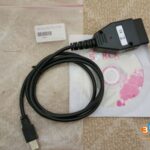For Audi A4 2014 owners, understanding your vehicle’s diagnostic systems is crucial for maintenance and troubleshooting. One of the most important tools in modern car diagnostics is the OBD2 scanner. But before you can use one, you need to know where the OBD2 scanner plug is located in your Audi A4. This guide will quickly show you where to find it and why it’s essential.
The OBD2 port, or On-Board Diagnostics port, is a standardized connector found in most cars manufactured after 1996. It provides access to your car’s computer system, allowing mechanics and car owners to read diagnostic trouble codes, monitor vehicle parameters, and even perform some basic programming.
In the Audi A4 2014 model, the OBD2 scanner plug is typically located in the driver’s side footwell area. You will usually find it under the dashboard, near the steering column. It’s often positioned above the pedals, making it easily accessible from the driver’s seat.
To locate it precisely:
- Get into the driver’s seat: Ensure your car is parked safely.
- Look under the dashboard: Direct your gaze to the area beneath the steering wheel.
- Search for a trapezoid-shaped port: The OBD2 port is usually black or sometimes colored and has a distinctive trapezoidal shape with 16 pins.
- Check above the pedals: In many Audi A4 2014 models, it is situated just above the accelerator and brake pedals.
Once you’ve located the OBD2 port, using a scanner becomes straightforward. Simply plug your OBD2 scanner into this port. With the ignition turned to the “ON” position (engine off), the scanner can communicate with your Audi’s computer. This connection allows you to read error codes, which can help identify issues like aCheck Engine Light, ABS problems, or other sensor malfunctions.
Having easy access to the OBD2 port in your Audi A4 2014 empowers you to take a proactive approach to vehicle maintenance. Whether you’re a seasoned DIYer or just want to understand your car better, knowing the location of this port is your first step into the world of modern car diagnostics.
